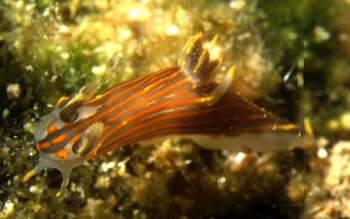Polycera quadrilineata from Turkey
May 29, 2003
From: Haluk Akbatur

Dear Bill,
Here is another nudi from Uc Adalar, East coast of Turkey. I have read the different messages and replies about the difference between Polycera quadrilineata and ,Polycera aurantiomarginata recently. I have some difficulty in identifying this dorid. Is it a Roboastra luteolineata or Polycera sp.? Specimens were seen on 18 May 2003, Dive site: Uc adalar (South-west of Turkey, Mediterranean coast,] Size: 1.5 cm, Depth:3-5m.
There are some yellow marks along the edge of the foot. Could you confirm it is Polycera quadrilineata please?
Haluk Akbatur
Lasergoz@ttnet.net.tr
Akbatur, H., 2003 (May 29) Polycera quadrilineata from Turkey. [Message in] Sea Slug Forum. Australian Museum, Sydney. Available from http://www.seaslugforum.net/find/10053Dear Haluk,
Firstly, the long papillae or tentacles around the front of the head are a sign that it is most probably a species of Polycera rather than a species of Roboastra. As to which species you have. As you say P. aurantiomarginata always has an orange border to the foot as its name suggests. But if you look at Jean-Pierre Bielecki's message, it seesm a few yellow spots along the edge of the foot are sometimes present in P. quadrilineata.
The two species can also be distinguished in the colour of the rhinophore club - in P. aurantiomarginata at least the upper half, but not the tip is bluish-black, and in P. quadrilineata, yellow or orange. Similarly the apical part of the gills are black in P. aurantiomarginata and yellow in P. quadrilineata. In you animal, both these characters match the colour pattern for P. quadrilineata. See also the discussion concerning Baki's photos from the same locality
Best wishes,
Bill Rudman
Related messages
-
Re: Thecacera? or Polycera? species - From Ratnagiri, India
From: Vishal Bhave, May 11, 2009 -
Polycera quadrilineata and bryozoans
From: Joao Pedro Tojal Loia Soares Silva, April 24, 2008 -
Re: Ancula gibbosa from Scotland
From: Jim Anderson, June 15, 2006 -
Re: Ancula gibbosa from Scotland
From: Jim Anderson, June 14, 2006 -
Re: Ancula gibbosa from Scotland
From: Marina P. Ossokine, June 14, 2006 -
Ancula gibbosa from Scotland
From: Jim Anderson, June 12, 2006 -
Polycera quadrilineata or Trapania tartanella ?
From: Stephane Ores, June 8, 2006 -
Polycera quadrilineata from Portugal
From: Joao Pedro Silva, March 2, 2004 -
Polycera quadrilineata from Turkey
From: Ferda Buyukbaykal, August 23, 2003 -
Polycera quadrilineata from northern Spain
From: Ricardo Roberto Fernández, July 12, 2003 -
Re: Unknown dorid from French Brittany
From: Juan Lucas Cervera, September 23, 2002 -
Re: Unknown dorid from French Brittany
From: Bernard Picton, September 23, 2002 -
Unknown dorid from French Brittany
From: Marina Poddubetskaia, September 18, 2002 -
Polycera quadrilineata from French Brittany
From: Marina Poddubetskaia, September 3, 2002 -
Polycera quadrilineata from France
From: Marina Poddubetskaia, July 23, 2002 -
Re: Polycera quadrilineata
From: Jean-Pierre Bielecki, June 20, 2002 -
Re: P. quadrilineata or P. aurantiomarginata?
From: Juan Lucas Cervera, June 19, 2002 -
Polycera quadrilineata or P. aurantiomarginata?
From: J-P. Bielecki , June 18, 2002 -
Re: Polycera aurantiomarginata? from Turkey
From: Juan Lucas Cervera, June 18, 2002 -
Re: Polycera aurantiomarginata from Turkey (2)
From: Lucas Cervera , June 18, 2002 -
Polycera aurantiomarginata? from Turkey
From: Baki Yokes, June 16, 2002 -
Larvae of Polycera quadrilineata
From: Nick Hudson, October 27, 2001 -
Polycera quadrilineata from Holland
From: Peter van Bragt, August 6, 1999 -
Polycera quadrilineata from Wales
From: Daniel Geiger, August 5, 1999
